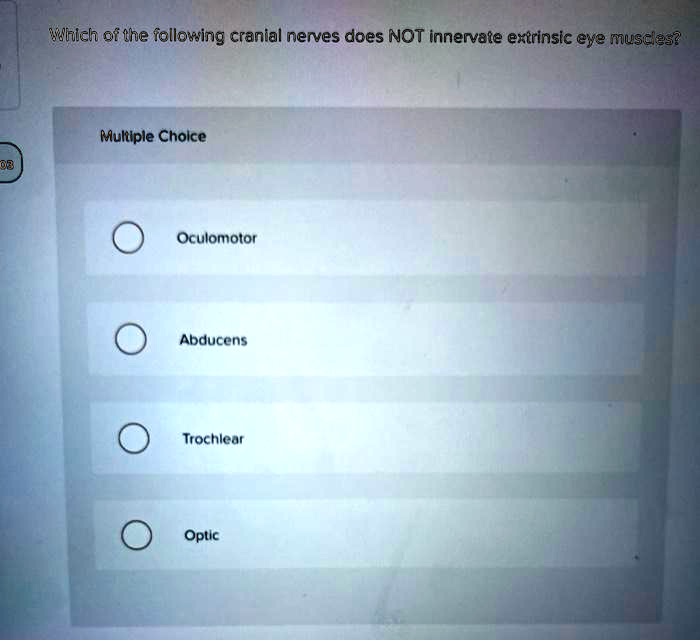
Have you ever gazed at the intricate movements of the eyes, marveling at their dexterity and precision? The ability to focus on objects, track motion, and adjust to varying light conditions is a remarkable combination of muscle coordination and neural control. However, not all cranial nerves play a direct role in innervating the extrinsic eye muscles. This poses an intriguing question for biology enthusiasts: Which cranial nerve does not partake in this ocular orchestration? Delving into this query unveils a fascinating interplay between anatomy and physiology.
The human anatomy comprises twelve pairs of cranial nerves, each serving unique functions. Among these, several cranial nerves are vitally implicated in eye movements. The extrinsic eye muscles—those situated outside the eyeball—are primarily responsible for tracking and orienting our gaze. This muscular arrangement allows for the efficient movement of the eyelids and the convergence of the eyes. The principal cranial nerves involved in the innervation of these muscles include the oculomotor nerve (CN III), the trochlear nerve (CN IV), and the abducens nerve (CN VI).
The oculomotor nerve is paramount, innervating the majority of extrinsic eye muscles. It facilitates movements such as adduction (moving towards the nose), elevation (looking up), and depression (looking down). The trochlear nerve merits attention as well; it single-handedly innervates the superior oblique muscle, enabling the eye to rotate downwards and laterally. The abducens nerve controls the lateral rectus muscle, responsible for abduction (moving away from the nose). Together, these nerves orchestrate intricate eye movements, enabling our ability to see the world in three dimensions.
However, amidst this ensemble, one cranial nerve stands apart—it does not contribute to the innervation of the extrinsic eye muscles. Can you guess which one? The answer is the optic nerve (CN II). While pivotal in vision, primarily conveying visual information from the retina to the brain, the optic nerve does not innervate any of the extrinsic muscles that control how we move our eyes. This distinction is crucial for understanding the distinct roles each cranial nerve plays in the sensory and motor functions of the human body.
The optic nerve’s primary function resides in its role as a sensory nerve, comprising an intricate network of axons that relay illuminated images to the brain for processing. It is an essential player in visual perception but has no direct influence over the muscular movements that allow us to gaze about our environment. Thus, while the optic nerve is indispensable for sight, it does not engage in the motor activities that direct our eye movements.
To appreciate the significance of this distinction, one must contemplate the elegant coordination required for a wide range of ocular movements. Imagine watching a soccer match; the rapid shifts in your gaze from players to the ball to the action on the sidelines articulate the need for seamless execution of eye movements. These movements are orchestrated by the extrinsic eye muscles, governed by the appropriate cranial nerves, which ensure that your vision is sharp and your tracking of objects fluid. The dysfunction or neuropathy of any of these nerves may result in strabismus or diplopia, conditions where the coordination of eye muscles fails, leading to misalignment or double vision.
In addition to stimulating muscle contractions, the proper functioning of the innervating cranial nerves ensures that our visual field is comprehensive and dynamic. Engaging both near and far objects, allowing for depth perception, hinges on the coordination of the aforementioned cranial nerves; the oculomotor, trochlear, and abducens are entirely devoted to this task. The optic nerve, however, serves a different purpose, cementing its status as a crucial yet non-motor player in the realm of vision.
In conclusion, the answer to the posed question is the optic nerve (CN II), which does not innervate the extrinsic eye muscles. Grasping this intricate relationship results in a deeper appreciation for the essential functions of the cranial nerves. From coordinating minute adjustments to enabling sharp focal shifts, the synergy among the cranial nerves plays a critical role in our daily experiences. So, the next time you ponder over the marvels of vision and eye movement, remember the pivotal roles that these nerves play, while bearing in mind the optic nerve’s distinct position. Understanding the anatomy and functionality of cranial nerves enriches our knowledge of the human body, laying the groundwork for future explorations into the realms of neuroscience and anatomy.
